In the bustling world of business, where every interaction can pivot the trajectory of your professional relationships, the art of sending a thank-you email after a meeting is not just courtesy—it’s a strategic tool. This seemingly simple gesture can set the tone for future interactions, solidify the foundation of your business relationships, and open doors to new opportunities. In this comprehensive guide, we delve into the nuances of crafting the perfect thank-you email, ensuring that your message resonates with your clients and reinforces your professional image.
The art of follow-up emails after business meetings
In the world of business, follow-up emails are more than just courtesy; they are a crucial part of professional communication, especially after a significant meeting with a client. These emails serve as a bridge between the conversation you have and the future relationship you wish to build. In this article, we delve into the nuances of crafting the perfect thank-you email after a business meeting, emphasizing the ideal timing for sending such a follow-up.
The ideal timing for sending a thank-you email after business meeting
When it comes to follow-up emails after a business meeting, timing is everything. The golden rule? Send your thank-you email within 24 hours of your meeting. This prompt follow-up is more than just a display of good manners.
Imagine this: You’ve just concluded a productive meeting with a potential client, where key points were discussed and ideas exchanged. The moment you part ways, your client dives back into their busy schedule, their attention pulled in multiple directions. By sending a quick follow-up within the same day, you ensure that the momentum gained during your meeting isn’t lost. This timely response not only shows your genuine interest and commitment but also demonstrates your professionalism and respect for their time.
Moreover, this quick turnaround time for your follow-up message helps keep everyone on the same page. It’s an opportunity to reiterate the main points discussed, ensuring that no detail is lost in the hustle of a busy workday. It’s not just about showing gratitude; it’s about reinforcing the key elements of your conversation and setting the stage for the next steps.
A well-timed thank-you email can distinguish between being remembered and being forgotten. So, when you hit send on that follow-up email, remember, you’re not just thanking your client for their time—you’re also paving the way for a fruitful professional relationship.
Crafting a compelling subject line for your follow-up email
The subject line of your follow-up email is your first, and sometimes only, chance to capture your recipient’s attention. It’s the gateway to your thank-you message, and its effectiveness can significantly influence whether your email gets opened or lost in the abyss of an overflowing inbox. A compelling subject line acts like a clear subject line, offering a sneak peek into the content of your email, while also being intriguing enough to prompt immediate opening.
- Be clear and direct: The best subject lines leave no room for guesswork. They should clearly state the purpose of the email. For instance, “Thank You for the Insightful Meeting” or “Appreciating Our Discussion Today” are straightforward yet effective. They immediately inform the recipient about the email’s intent.
- Personalize it: Adding a personal touch can make your email stand out. Include the recipient’s name or a specific point from the meeting to make it more personal. For example, “John, Your Insights on Market Trends Were Invaluable!” shows that you’re not just sending a generic follow-up message.
- Reference the meeting context: If your meeting was part of a larger event, such as a conference or networking event, mention it. “Great Meeting You at [Event Name]” or “Following Up from Our Chat at [Conference Name]” helps the recipient place you and the context of your meeting.
- Keep it short and sweet: Long subject lines often get cut off, especially on mobile devices. Aim for brevity while maintaining clarity. “Thanks, [Name]! Let’s Talk More About [Topic]” is concise and to the point.
- Spark curiosity: Sometimes, a bit of intrigue can work wonders. “A Quick Thought Post Our Meeting” or “One More Idea Regarding Our Discussion” can pique interest and prompt the recipient to open the email.
- Highlight a mutual benefit: If your meeting discussed potential collaboration or mutual benefits, hint at this in your subject line. “Excited About Our Joint Venture Possibilities” or “Looking Forward to Mutual Growth” can be effective.
- Use a professional or formal tone: Employ a tone that is either professional or formal, as appropriate. While creativity is valued, it’s important to avoid casual language or slang. The tone should reflect the nature of your relationship and the context of your meeting. Our AI assistant aids in ensuring this balance, helping to maintain the right level of professionalism and formality in your communication.
Examples of effective subject lines:
- For a general business meeting: “Thank You, [Recipient’s Name], for a Productive Meeting!”
- Post a job interview: “Grateful for the Opportunity, [Interviewer’s Name]”
- After a sales pitch: “Excited About Our Next Steps in Collaboration”
- Following a networking event: “Inspired by Our Conversation at [Event Name]”
Remember, your subject line is the first impression you make post-meeting. It sets the tone for your email and can be the deciding factor in whether your message is read or ignored. Crafting a subject line that is clear, personalized, and engaging will increase the chances of your email being opened and read, moving you one step closer to solidifying your professional relationships.
Mastering the art of follow-up emails after business meetings
Whether it’s a thank-you email after a productive meeting, a meeting recap email, or a follow-up meeting email, each communication serves a unique purpose. We’ll explore how personalization, gratitude, a summary of key points, effective call-to-action (CTA), and the perfect sign-off can transform your follow-up emails into powerful tools for fostering customer satisfaction, reinforcing professional relationships, and paving the way for future opportunities.
Personalization is key in follow-up emails
In the realm of follow-up emails, personalization is not just a buzzword; it’s a crucial element that transforms your message from a generic note into a meaningful conversation. Customizing your email to reflect the specific discussion with the client does more than just show that you were paying attention; it demonstrates your genuine interest in the relationship and the subject matter discussed.
How to personalize your email:
- Refer to specific discussion points: Mention particular topics, ideas, or challenges discussed during the meeting. For example, “I’ve been thinking more about the marketing strategy we discussed and particularly about your suggestion on social media engagement.”
- Use their name: It might seem simple, but addressing the recipient by their name immediately adds a personal touch to your email.
- Reflect on shared experiences: If your meeting had any memorable or unique moments, bring them up. “I thoroughly enjoyed our conversation about the upcoming industry trends, and your story about your first major project was particularly inspiring.”
- Link to their goals or challenges: Show that you understand and care about their objectives or the challenges they are facing. “I understand that increasing customer satisfaction is your top priority right now, and I believe our solution can significantly aid in that regard.”
- Offer additional value: If you can provide a resource, a piece of information, or a connection that is relevant to what was discussed, include it in your email. “I came across this article on customer engagement strategies and immediately thought of our discussion yesterday. I hope you find it as insightful as I did.”
Example of a personalized email segment:
“Dear [Client’s Name],
I hope this email finds you well. I am writing to express my gratitude for our meeting yesterday. Discussing your upcoming project, especially your innovative approach to [specific aspect], was incredibly enlightening. I was thinking about potentially integrating [a related idea or solution] to further enhance the outcome. Also, your anecdote about [a personal story or joke shared] really resonated with me—it’s not every day you meet someone with such insightful experiences.”
Expressing gratitude with elegance in your thank-you email
Expressing gratitude in your follow-up email is more than a mere formality; it’s an opportunity to leave a lasting impression. The key lies in articulating your appreciation in a way that feels sincere and personal rather than generic and perfunctory. Striking the right balance between professionalism and warmth can transform your thank you email into a memorable and impactful message.
Crafting a genuine message of thanks:
- Be specific: General statements like “Thank you for your time” are polite but forgettable. Instead, be specific about what you are thankful for. For instance, “Thank you for sharing your insights on [specific topic]” or “I appreciate the opportunity to learn about [specific aspect of their business].” This specificity not only shows that you were engaged during the meeting but also that you value their unique contributions.
- Reflect on the meeting’s value: Express gratitude by highlighting how the meeting was beneficial to you. For example, “Our discussion gave me a new perspective on [topic] and has been incredibly valuable in shaping my approach to our upcoming project.”
- Personalize your appreciation: If something in the meeting resonated with you on a personal level, mention it. “I am particularly grateful for your advice on [personal advice], as it aligns closely with my current professional journey.”
- Warmth and professionalism: The tone of your thank-you should be warm yet professional. This can be achieved by using friendly yet respectful language. Phrases like “I am truly grateful” or “I sincerely appreciate” can convey warmth without compromising professionalism.
- Acknowledge their effort: Recognize the effort they put into the meeting. “I understand how busy your schedule is, and I am grateful for the time and effort you took to meet with me.”
Example of expressing gratitude in an email:
“Dear [Recipient’s Name],
I wanted to take a moment to express my heartfelt thanks for our meeting on [date]. Your detailed insights into [specific topic] were not only helpful but truly inspiring. I appreciate the time you took from your busy schedule to discuss [specific points] with me. Our conversation has given me valuable perspectives that I am eager to apply in my work.
Thank you once again for your generosity in sharing your expertise and for the engaging and productive conversation. I am looking forward to the possibility of collaborating in the future and continuing our discussion.”
Summarizing key meeting points in your meeting recap email
A concise and effective summary of the key points discussed during your meeting is essential to a follow-up email. This recap serves as a reminder of what was covered and demonstrates your attentiveness and understanding of the meeting’s content. Additionally, it helps ensure that both parties are aligned with any agreements or action items established.
The art of concise recapitulation:
- Highlight main topics: Start by briefly outlining the main topics of the discussion. This doesn’t mean rehashing the entire conversation but rather focusing on the core subjects. For example, “I appreciated our discussion on [main topic], especially the part about [specific detail].”
- Summarize agreements and decisions: If any agreements were made or decisions taken, clearly state them. This could be in the form of “We agreed that [specific action] would be the next step forward” or “I am excited to start working on [agreed-upon task].”
- Mention action items: If specific action items were identified during the meeting, recap them along with any assigned responsibilities. For instance, “As discussed, I will send over the detailed proposal by [date], and you will provide feedback by [date].”
- Keep it brief and focused: The summary should be brief yet comprehensive. Avoid going into too much detail; focus on capturing the essence of the discussion and the outcomes.
- Use bullet points for clarity: If there are multiple points or action items, bullet points can effectively organize the information clearly and concisely.
Example of a meeting recap in an email:
“Dear [Recipient’s Name],
I wanted to recap the key points from our meeting to ensure we’re on the same page moving forward:
We discussed the potential for [main topic], and you shared valuable insights on [specific detail].
We agreed that implementing [specific strategy] would be beneficial for both parties.
Action items:
- I will forward the detailed report on [topic] by [date];
- you will provide feedback and any additional requirements by [date];
- we are both excited about exploring [potential opportunity] and agreed to schedule a follow-up meeting in two weeks to review progress;
- I believe these steps will significantly contribute to our project’s success and I am looking forward to seeing our plans come to fruition.”
The call-to-action (CTA) in your follow-up meeting email
A CTA in your follow-up email is crucial, as it guides your recipient toward the next step. Whether it’s to encourage further communication or to set up a subsequent meeting, your CTA should be clear and direct, yet tactful, avoiding any tone of aggression or pushiness.
Crafting an effective CTA:
- Be specific and direct: Clearly state what action you want the recipient to take next. For example, “Please let me know a convenient time for our next meeting,” or “I would appreciate your feedback on the proposed plan by [specific date].”
- Make it easy to respond: Offer options or suggest specific dates and times for a follow-up meeting. This reduces the effort required by the recipient to respond and increases the likelihood of a prompt reply.
- Use encouraging language: Phrases like “I look forward to hearing from you” or “I am eager to continue our discussion” are inviting and express enthusiasm without being overbearing.
- Align the CTA with meeting outcomes: Ensure that your CTA is relevant to the discussion and outcomes of your meeting. It should feel like a natural next step in the progression of your conversation.
Example of a CTA in an email:
“As we discussed, the next step is to finalize the project timeline. Could you please share your availability for a brief call next week to discuss this? I am available on Tuesday and Thursday afternoons, but I am happy to adjust to your schedule.”
The perfect sign-off: Professional email signature for business meetings
The sign-off is your final opportunity to leave a positive impression. It should be professional yet convey a sense of warmth and approachability.
Choosing the right sign-off:
- Match the tone of your email: If your email is formal, use a formal sign-off like “Best regards” or “Sincerely.” “Best wishes” or “Kind regards” can be appropriate for a more conversational tone.
- Add a personal touch: A little personalization can go a long way. For instance, “Looking forward to our next conversation” or “Wishing you a great week ahead” adds a friendly touch.
- Keep it professional: Regardless of the level of familiarity, always maintain a level of professionalism. Avoid overly casual sign-offs in a professional setting.
Example of a sign-off in an email:
“Thank you once again for a productive meeting. I am looking forward to taking our discussion forward. Best regards, [Your Name].”
Follow-up strategies for post-meeting communication
If your initial follow-up email doesn’t receive a response, it’s important to have a strategy for further follow-ups.
When and how to follow up:
- Give them time: Wait for about a week before sending a follow-up. This gives the recipient enough time to respond to your initial email.
- Be polite and concise: Your follow-up should be polite and to the point. A simple message asking if they had time to consider your previous email is sufficient.
- Reference your previous email: Briefly mention your previous email to jog their memory. For example, “I wanted to follow up on my email from last week regarding [topic].”
- Know when to stop: If you’ve sent two or three follow-ups with no response, it’s time to take a step back. Continuing to send emails can be seen as intrusive.
Keeping track of correspondence:
- Use email tracking tools: Tools like CRM software can help you keep track of sent emails and responses.
- Maintain a follow-up calendar: Note when you sent your initial email and when to send a follow-up.
- Organize your inbox: Use folders or labels to organize emails based on projects or urgency for easy reference.
Example of a follow-up email:
“Hi [Recipient’s Name],
I hope this message finds you well. I’m writing to follow up on my email from [date] about [specific topic]. I understand that you have a busy schedule, but I would appreciate any updates you might have. Please let me know if there’s a more convenient time for you to discuss this.
Thank you for your time, and I look forward to hearing from you.
Best regards,
[Your Name]”
Email templates for different scenarios: Networking event, job interview, and more
Email templates can be a great starting point for crafting your follow-up messages. They save time and ensure consistency in your communications. Below are 10 adaptable templates for various business contexts. Remember, these are meant to be guides—customize them to fit your specific situation and relationship with the recipient.
After the first meeting:
Subject line: Great to Meet You, [Recipient’s Name]!
Hi [Recipient’s Name],
Thank you for taking the time to meet with me today. I enjoyed our discussion about [specific topic] and found your insights extremely valuable. I’m looking forward to exploring how we can work together on this.
Let’s keep the conversation going. Are you available for a follow-up call next week?
Best regards,
[Your Name]
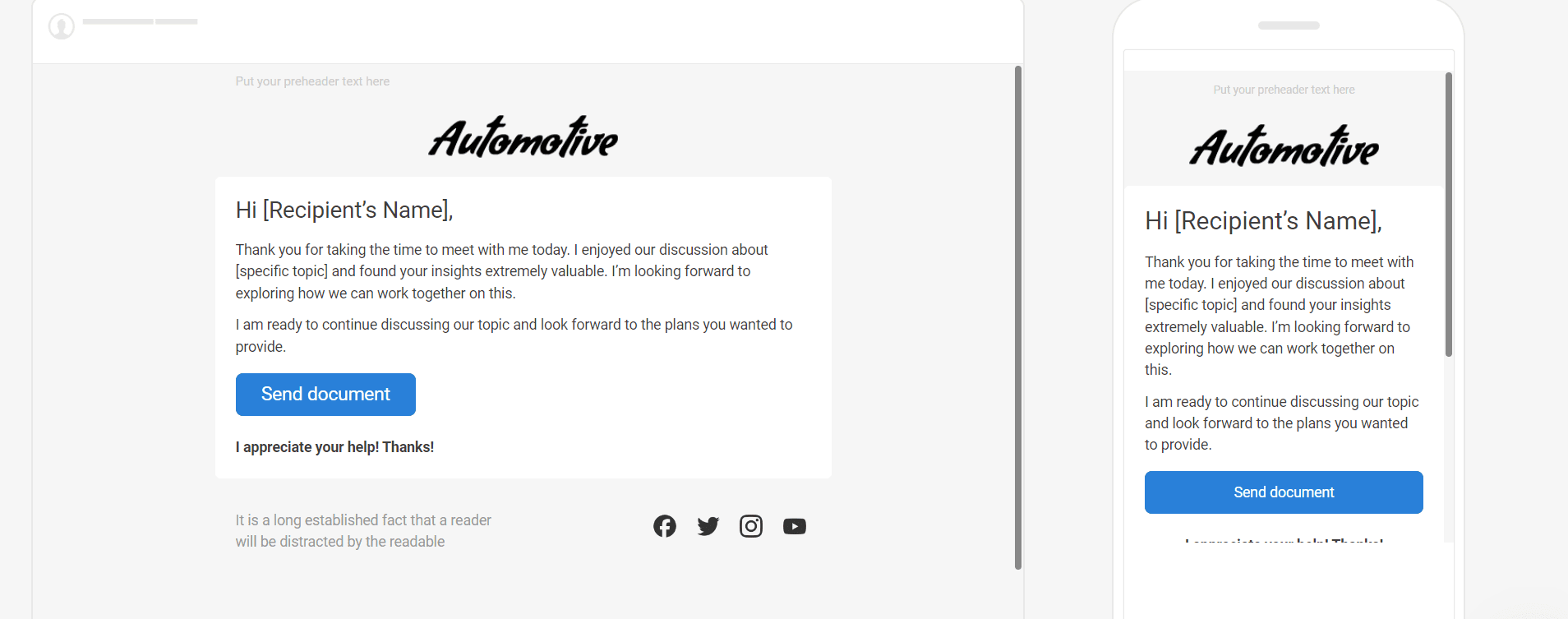
(Source: Stripo email template)
Post-project discussion:
Subject line: Reflecting on Our Recent Project
Hello [Recipient’s Name],
I am grateful for your hard work and dedication during our recent project. Your expertise in [specific area] really shone through and contributed to our success.
I’ve summarized our key achievements and learnings in the attached document. Let’s discuss how we can apply these insights to future projects.
Kind regards,
[Your Name]
After a networking event:
Subject line: Connecting After [Event Name]
Hi [Recipient’s Name],
It was a pleasure meeting you at [Event Name]. Your thoughts on [topic discussed] were particularly intriguing. I believe there’s a lot we can share and learn from each other.
How about we grab coffee next week to continue our conversation? Let me know your availability.
Best,
[Your Name]
Following up on a proposal sent:
Subject line: Following Up on Our Proposal—[Proposal Title]
Dear [Recipient’s Name],
I hope this email finds you well. I am following up on the proposal we sent last week regarding [proposal topic]. Your feedback would be invaluable in ensuring that it aligns perfectly with your needs.
Do let me know if you have any questions or require further information.
Warm regards,
[Your Name]
After a job interview:
Subject line: Thank You for the Opportunity—[Your Name]
Dear [Interviewer’s Name],
Thank you for the opportunity to interview for the [Job Title] position. I enjoyed learning more about [something specific about the company or role] and am even more enthusiastic about the prospect of joining your team.
I look forward to any updates regarding the position and am happy to provide any additional information needed.
Sincerely,
[Your Name]
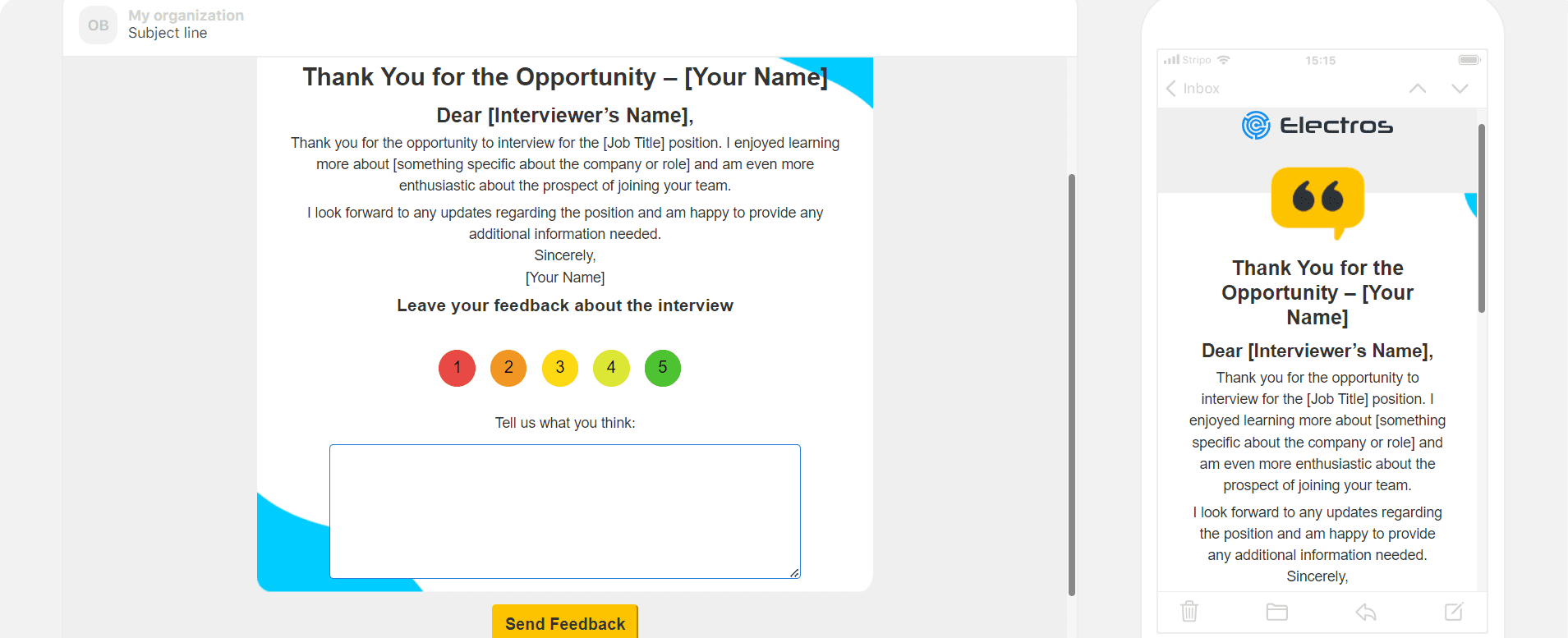
(Source: Stripo email template)
Each of these templates can be tailored to fit the unique circumstances of your meeting and relationship with the recipient. The key is to maintain a balance between professionalism and personal touch, ensuring that your follow-up is effective and leaves a positive impression.
Wrapping up
In the realm of professional networking, the thank-you email is a crucial tool, transcending mere courtesy to become a strategic asset. It's not just about expressing gratitude; it’s an opportunity to reinforce and deepen business relationships. Each well-crafted email serves as a thread in the fabric of professional connections, demonstrating your appreciation for the time and insights shared. This follow-up is a tangible expression of your commitment to nurturing and expanding these relationships. In business, where relationships equate to currency, a timely, thoughtful, and personalized thank-you email distinguishes you as a professional who is attentive, considerate, and genuinely invested in mutual growth. As you craft your thank-you emails, view each as a chance to strengthen professional bonds and pave the way for future collaboration and opportunities.



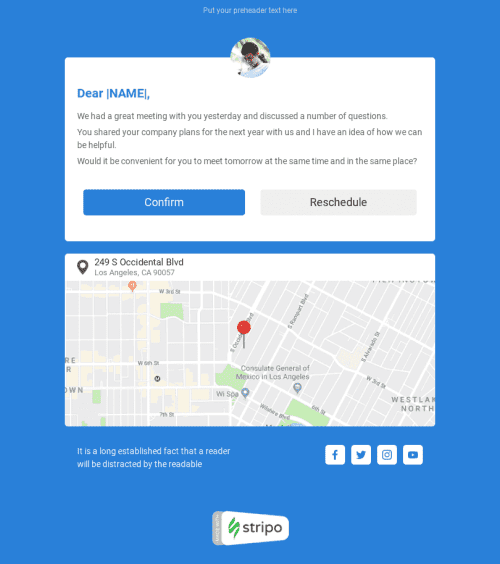
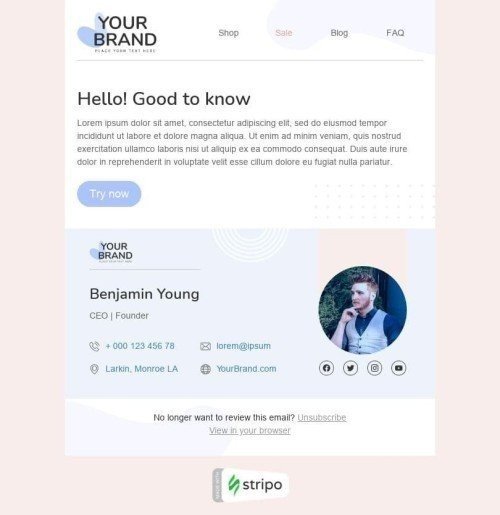

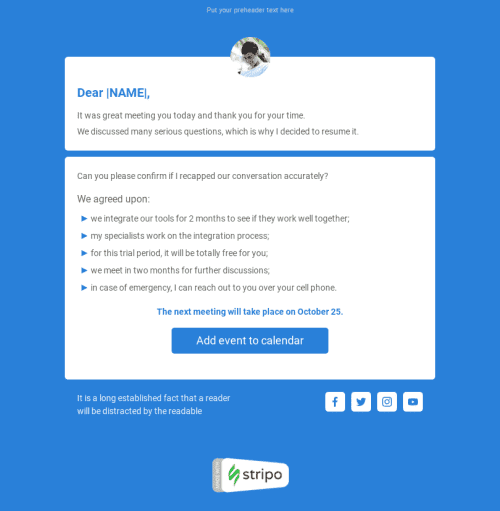
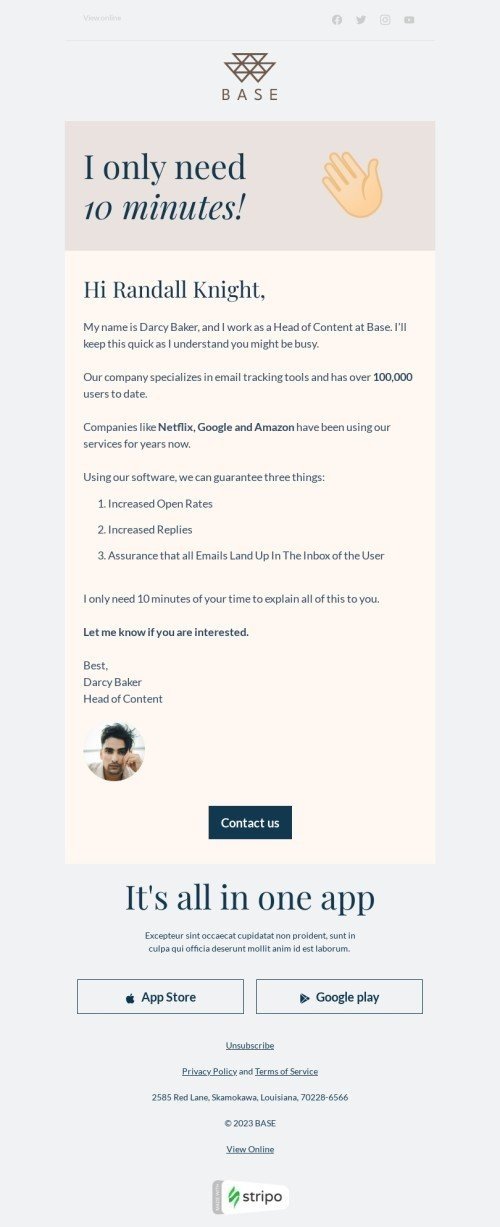

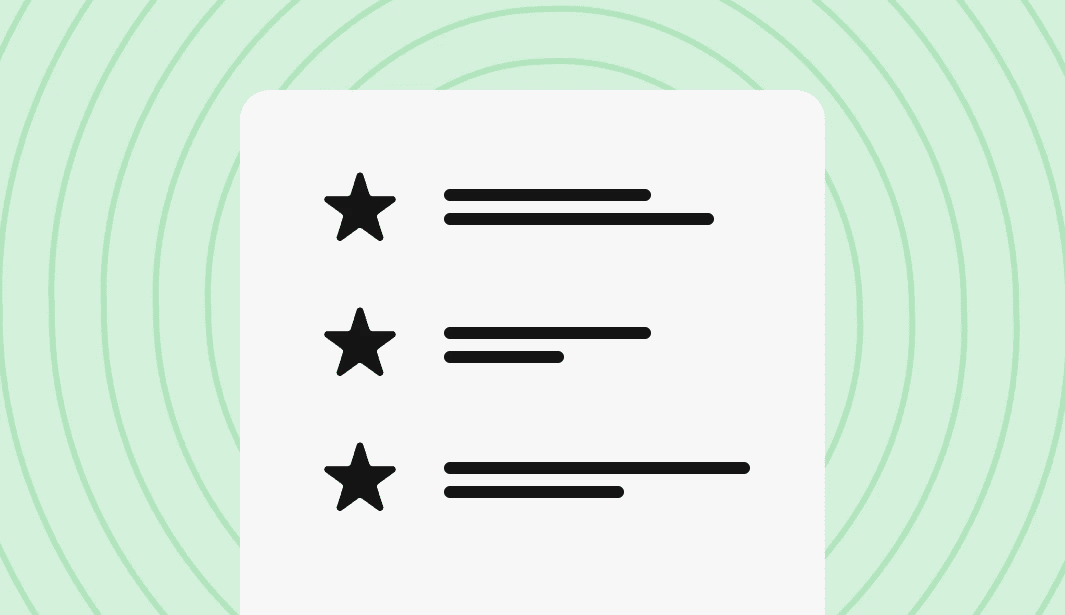


0 comments